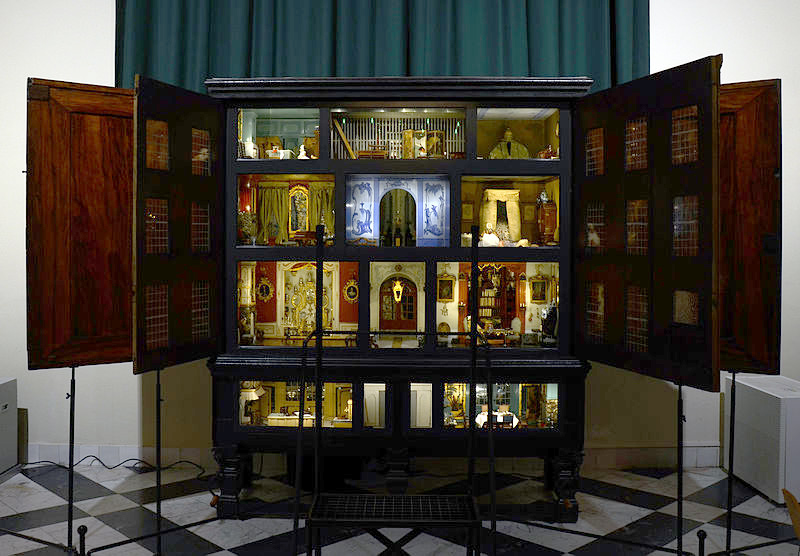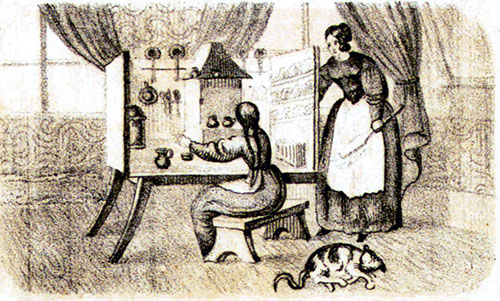The Art of Miniatures by Walter Arnell
Miniatures may be defined as “precisely scaled reproductions or creations of objects that are intended to create the illusion of reality.”
Where and when the art of miniatures began is not certain. The tombs of ancient Egyptians contained miniatures of favorite objects and necessary treasures to assist the occupant in his or her next journey. The archeological wings of all museums show us a multitude of miniatures from numerous civilizations. Many cultures, past and present have carved small animals, called fetishes, from ivory, bone, and semi-precious gems. Miniatures are found in other parts of museums, also. Before the development of photography, artists were commissioned to paint small portraits of loved ones so that their likenesses could be kept near and easily transported when traveling. A few well preserved, fully furnished houses dating from the sixteen hundreds and seventeen hundreds still exist and are viewed by hundreds in their museum homes. These gems of the miniature world are valuable not only because of their age and preservation, but because they present an accurate glimpse into the daily life of the time they represent. Dioramas are used to demonstrate a variety of things from the burial chamber in an Egyptian Pyramid to the life style of Southwestern Indians, to the brewing of whiskey in nineteenth century Scotland. Faberge eggs, many with miniature interiors, are yet another example of exquisite miniature art. Many famous architects have first expressed their genius in the form of an architectural model and architects continue to do this today. In the nineteenth century it became commonplace for furniture designers to make miniatures of their inventory. This made it easier to transport the items to potential customers. Even miniature sewing machines were produced. These beautiful small renditions of full size furniture are sought by collectors.

Dollhouse made in 1743 by Sara Rothé (1699-1751, Amsterdam)
on display in the Frans Hals Museum in Haarlem.
photo credit Vassil. Used under CC0 1.0 Public Domain Dedication
The concept of miniatures as toys is relatively new and occupies a very short period on the time line of miniature history. Doll houses for your girls became popular in the Victorian age when mass production made houses and furniture easily accessible and affordable. Functional miniature kitchens and millinery, apothecary, butcher, bakery and confectionary shops became extremely popular and were used as learning tools for future wives and mothers. Earlier houses, however, were owned by adults. They were often commissioned to hold extensive collections of miniature silver, gold and hand blown glass. These cabinet houses, as they were called, locked and were treated as a piece of furniture. Holland is still a producer of miniature silver and fine miniature glass can be found today in Venice, Italy. In times long gone, owners of large estates commissioned the estate carpenter to build a copy of their house. Whether these were played with by children is not clear, but some of them do remain to be enjoyed by us today.
If one wishes to replicate a Colonial house, a Louis XVI bed chamber, or scene from a famous book, one must begin with research. In the case of the book it must be read. One must learn about the architecture of the time involved and then the building materials. Next, it is necessary to research the proper furnishing s and their placement in the rooms. Then, the correct accessories must be ascertained even to the use of proper flowers and food for the era and place. For the person involved in this project, a new world is opened that fosters creativity, and educates in the fields of history, architecture, and culture. Even the construction of a fairy castle or gnome house requires research in the realm of fairy folklore. The cherished 1935 doll house that has been kept with all its furnishings will demonstrate to our grandchildren and future generations how people lived in the 1930’s and what products they used.

Illustratoin of a girl and her dollhouse from "Der kleine Kinderfreund"
published 1860. Public Domain
There is a long list of miniature artists from earlier years, many are unknown. Today, there are artists producing unbelievable works of art in a multitude of fields. Fine arts and practical arts are all represented. The categories are endless and range from entire buildings to fine paintings, perfectly scaled furniture, to working telescopes and musical instruments.
Not everyone has the talent to become an artist or master craftsman, but they can still participate in the miniature world. Everything that one builds or makes adds to our knowledge in many ways. Those who collect or simply view miniatures find themselves pulled into an educational time machine that has so many places to go that there is no foreseeable end to this fascinating adventure.
NAME Long Range Planning Committee Report
written by Walter Arnell - 2001
Having trouble with the website? Please click here to contact us about it.
